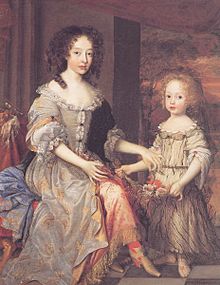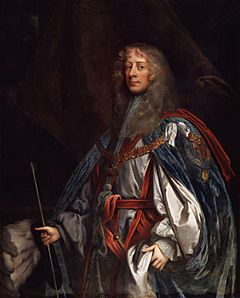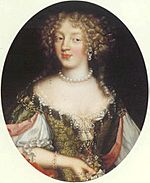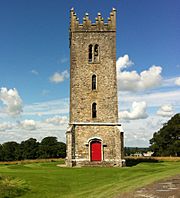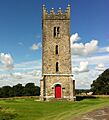Richard Talbot, 1st Earl of Tyrconnell facts for kids
Quick facts for kids
The Earl of Tyrconnell
PC
|
|
|---|---|
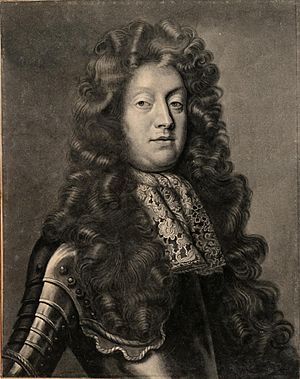
Watercolour after portrait by Godfrey Kneller
|
|
| Lord Deputy of Ireland | |
| In office 1687–1689 |
|
| Preceded by | The Earl of Clarendon |
| Succeeded by | Lords Justices |
| Personal details | |
| Born | c. 1630 possibly Dublin |
| Died | 14 August 1691 (aged 60–61) Limerick |
| Spouses |
|
| Relations |
|
| Military career | |
| Allegiance | |
| Service/ |
Cavalry |
| Years of service |
|
| Rank | Lieutenant general (Jacobite) |
| Battles/wars | |
Richard Talbot, 1st Earl of Tyrconnell (born around 1630 – died August 14, 1691), was an important Irish leader. He was a politician, a courtier (someone who attended a royal court), and a soldier. He is best known for trying to improve the lives of Irish Catholics.
Talbot started his career as a cavalry soldier in the Irish Confederate Wars. After spending some time in Europe, he joined the court of James, Duke of York. James was living in exile after the English Civil War. Talbot became a close and trusted friend of James.
When James's older brother, Charles, became king again in 1660, Talbot began to help Irish Catholics. Many Catholic families had lost their lands after the Cromwellian conquest of Ireland. Talbot worked to help them get their estates back. This became a very important part of his life's work. James also became Catholic later, which made his bond with Talbot even stronger.
When James became king in 1685, Talbot gained more power. He helped remove many Protestants from the Irish Army. Before this, most Catholics were not allowed to join. King James made Talbot the Earl of Tyrconnell. Later, he made him the Viceroy, or Lord Deputy of Ireland. In this role, Talbot quickly started putting Catholics into many government, political, and legal jobs.
Tyrconnell's plans were stopped when James was removed from the throne in 1688. This event is known as the Glorious Revolution. James's Protestant son-in-law, William of Orange, took his place. Tyrconnell remained loyal to James and supported him during the Williamite War in Ireland. However, he also thought about making peace with William to protect Catholic rights. He became very ill and died of a stroke in 1691, shortly before James's supporters were defeated.
Contents
Early Life and Family Background
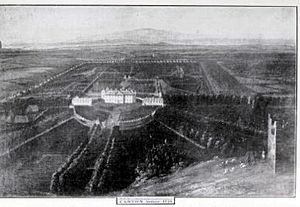
Richard Talbot was born around 1630, probably in Dublin, Ireland. He was the youngest of eight sons and one of sixteen children. His father was William Talbot, a lawyer and the first Baronet Talbot of Carton. His mother was Alison Netterville.
The Talbot family came from a Norman background. They had settled in Leinster in Ireland in the 1100s. From the late 1500s, families like the Talbots were called "Old English." This term referred to people of Anglo-Norman descent in Ireland. Like most "Old English" families, the Talbots remained Catholic. This was true even after the Church of Ireland was started under King Henry VIII.
Richard had several brothers. His brother Robert (c.1610–1670) became the second baronet after their father. Another brother, Peter (1620–1680), was a Jesuit priest who became the Catholic archbishop of Dublin. At least three of his brothers became religious leaders in Europe.
We don't know much about Talbot's childhood. As an adult, he was very tall and strong for his time. One writer described him as "one of the tallest men in England." He was also considered very handsome. However, he was known for having a quick temper. He would often throw his wig when he was angry! He also had a reputation for fighting duels, which earned him the nickname "Fighting Dick Talbot."
Military Beginnings in Ireland
Talbot started his military career during the Irish Confederate Wars. These wars followed the Irish Rebellion of 1641. He served as a cavalry cornet (a junior officer) in the Confederate Leinster army. His commander was Thomas Preston.
In 1647, Preston's army was defeated at Dungan's Hill. The winning Parliamentarian forces killed thousands of Irish soldiers. Talbot was very lucky to be rescued and returned to his side.
In September 1649, he was part of the Royalist and Confederate army defending Drogheda. This town was under siege by Parliamentarian forces. Talbot survived the terrible killing of the defenders because he was so badly wounded that he was thought to be dead. He later escaped the town disguised as a woman. He then left Ireland and went to Madrid, Spain, in 1653. There, he served as a captain in the Spanish army with other Irish and Royalist exiles.
Joining the Stuart Royal Family
In 1655, Talbot met Charles II, the exiled King of England. Talbot offered to join a plan to kill Oliver Cromwell, who was then leading England. However, Talbot was arrested in England in July after the plan was discovered. He was arrested again in November.
Talbot was questioned by Cromwell's spymaster, John Thurloe. Cromwell himself was there for part of the questioning. Cromwell supposedly asked Talbot why he wanted to kill him. Talbot was threatened with torture and sent to the Tower of London. That night, he used his last money to give wine to Cromwell's servants. Then, he climbed down a rope to a waiting boat and escaped to Antwerp. Some people later wondered if Talbot was allowed to escape in exchange for information. Nothing was proven, but it made some "Old Royalists" suspicious of him.
In 1656, Talbot's brother Peter introduced him to James, Duke of York. Richard and James became very close friends for life. James made Talbot a Gentleman of the Bedchamber, a trusted position at court. Later, James put Talbot in charge of his own army regiment. This was against the advice of the Duke of Ormond, a leading Irish Royalist. Ormond did not trust Talbot because he was Catholic.
Despite Ormond's concerns, Talbot served with James's regiment in Flanders in 1657. He was also present at the Siege of Dunkirk in 1658.
The King Returns to Power
Talbot's influence grew after King Charles II returned to the throne in 1660. He went to England and kept his job as Gentleman of the Bedchamber. He also went on several diplomatic trips for the royal family.
The Act of Settlement 1662 was a law that rewarded those who had fought for the Royalists. It partly reversed the land changes made by Cromwell in Ireland. Talbot started working as a land agent. He helped people who wanted to get back estates that had been taken from them. Some of his clients were Irish Catholic landowners. But he also helped James and other important people at court. After 1663, he pushed for Catholic landowners to have their cases heard in a new law.
During this time, he again argued with Ormond, who was now the Viceroy in Ireland. Their argument ended with King Charles sending Talbot to the Tower of London for a month.
Over the next ten years, Talbot used his influence with James to strengthen his position at court. He also started making connections with others who wanted to replace "Old Royalists" like Ormond. Talbot remained a person who caused strong opinions at court. This was because of his strong personality and his "strong opinions expressed with much swearing." In 1669, he married Katherine Baynton, who was known for her beauty. They had two daughters, Katherine and Charlotte. Katherine Baynton died in 1679.
In February 1669, Ormond was dismissed. King Charles began to ease rules against Catholics. Around the same time, James secretly became Catholic. In 1670, Talbot presented himself as the "agent general" for Irish Catholics. He asked for the land issue to be looked at again. His efforts seemed to be working. But they stopped in 1673 when Parliament acted to limit Catholic influence at court. The Test Act of 1673 made James's conversion to Catholicism public. Since James could no longer support him openly, Talbot was kept away from court for the next ten years. He spent much of this time in Yorkshire with his wife's family. Later, he settled on his estate at Luttrellstown, County Dublin.
Challenges and a New Marriage
In August 1679, Talbot had to flee from Ireland to France. He wanted to avoid being arrested for being involved in the Popish Plot. This was a time of great fear and false accusations against Catholics. His brother Peter was not as lucky. He was named as a key plotter and died in prison in November 1680.
In Paris, Talbot met his old love, Frances Jennings. She was the sister of Sarah Jennings, who would later become the famous Sarah Churchill, Duchess of Marlborough. Talbot and Frances married in 1681. He returned to London in 1683 after the discovery of the Rye House Plot. This was a plan by some Protestants to kill King Charles and James. King Charles then allowed Talbot to live in Ireland, own horses and weapons, and travel freely. His chances improved quickly as James gained more power at court and was confirmed as the next king.
Becoming Lord Deputy of Ireland
Despite being Catholic, James became King of England, Scotland, and Ireland after his brother's death in 1685. He had a lot of support. Many people feared another civil war and were happy about the peaceful transfer of power. Rebellions by Charles's son Monmouth and the Earl of Argyll were quickly put down.
King James rewarded Talbot's loyalty. He made him Baron of Talbotstown, Viscount Baltinglass, and Earl of Tyrconnell. James sent him to Ireland as the commander in chief of the Irish Army. James had already ordered Protestant militias to be disbanded. With James's approval, Tyrconnell now began to recruit many Catholics into the army. By the summer of 1686, two-thirds of the regular soldiers and 40% of the officers were Catholic.
The Viceroy, the Earl of Clarendon, received reports of tension between Catholic army units and Protestants. This caused worry in both Ireland and England. Clarendon's secretary noted that "the Irish talk of nothing now but recovering their lands."
Despite some resistance from James, Tyrconnell continued to work on improving the legal status of Irish Catholics. In 1686, he got Catholics admitted to the Privy Council (a group of royal advisors). He also had one Catholic judge appointed to each of the three main law courts. When he tried to reopen the question of returning Catholic estates, James held back. This was partly because English Catholics worried about how Tyrconnell's actions might affect Protestant opinion. Clarendon found Tyrconnell's presence in Ireland very difficult.
King James appointed Tyrconnell Lord Deputy of Ireland in 1687, replacing Clarendon. James did not want to upset Irish Protestants. He made it clear that Tyrconnell should not fire anyone because of their religion. He also said no to a law about the land question. However, he suggested he might call an Irish parliament later to discuss it. James limited Tyrconnell's power by making him Lord Deputy, not Lord Lieutenant. He also made Tyrconnell accept Thomas Sheridan as his Chief Secretary, even though Tyrconnell didn't want him.
Still, Tyrconnell went ahead and appointed Catholics to most Irish government departments. Only the Treasury remained under Protestant control. By issuing new town charters, he quickly made the local governments more Catholic. This was in preparation for a future meeting of Parliament.
The Glorious Revolution and War
James was in his 50s and had no sons. His daughters were Protestant. Tyrconnell's main goal was to build a strong Catholic government that could last even after James died. But his changes happened so fast that they caused problems in all of James's kingdoms. In early 1688, he sent two judges to London with plans for land laws. Tyrconnell hoped that the second plan, which suggested splitting estates, would satisfy Protestants. He wrote to James that it would solve the issue with "as little disturbance as possible to the protestant interest." However, his plans were put on hold after two events created a crisis for James.
On June 10, a son, James Francis Edward, was born to King James. This meant there was now a Catholic heir to the throne. This pushed aside James's Protestant daughter Mary and her husband William of Orange. Also, James tried to prosecute seven bishops, which seemed like an attack on the Anglican Church. Their acquittal on June 30 greatly weakened James's power.
Tyrconnell saw the crisis coming. In August, he warned James that a coup was being planned in Holland. In September, James ordered him to send 2,500 Irish soldiers to England. This included some of his best troops. Tyrconnell reluctantly obeyed. He knew that Ireland's safety depended on James's other kingdoms.
After William landed in England in November (the Glorious Revolution) and James fled in December, Tyrconnell faced many challenges in Ireland. Many Protestants fled to Ulster or England. Tyrconnell tried to secure towns with loyal Catholic army units. But he failed in the north at Enniskillen and Derry, which were held by Protestant militias. He was shocked by how quickly James fell from power. He briefly thought about negotiating with William. He said he would consider disbanding the army if Catholics could keep their position as it was at the end of Charles's reign. William seemed willing to accept this, but Tyrconnell later decided against it.
The Williamite War in Ireland
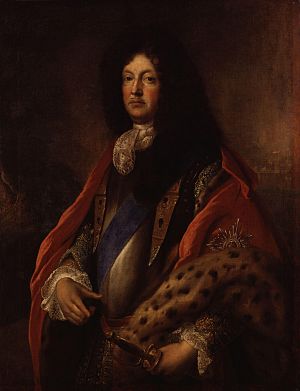
In January, Tyrconnell ordered a huge expansion of the Irish army, by 40,000 men. He gave commissions to Catholic landowners to raise new regiments. By spring 1689, the army was supposedly around 36,000 strong. However, there was little money to pay them, and not enough experienced officers.
King James, along with French army officers, landed in Kinsale on March 12. He planned to use Ireland as a base to retake England and Scotland. He met Tyrconnell in Cork a few days later. James made him Duke of Tyrconnell and Marquess of Tyrconnell. These titles were only recognized by James's supporters, the Jacobites.
Tyrconnell was busy preparing for the Parliament meeting in May. This meeting was very important to raise money for the war and to create a new land law. Because of his work as Viceroy, the "Patriot Parliament" was mostly Catholic. However, at this critical time, Tyrconnell became very ill. This meant he could not attend the Parliament he had worked so hard for. He did not return to public life until August.
Tyrconnell's absence meant that Parliament rejected his original, more moderate plan for the land law. This plan was meant to calm Protestant opinion. To James's dismay, Parliament would not give him money unless he agreed to a much more extreme plan. This plan would completely undo the land changes made by Cromwell.
By the time Tyrconnell recovered, the military situation in the north had gotten worse. On July 28, forces under Percy Kirke helped Derry, and the Jacobites had to retreat. A large army led by Schomberg landed in Belfast Lough and captured Carrickfergus. Schomberg marched south to Dundalk and threatened to advance on Dublin. After a long standoff, both armies went into winter camps. Both Tyrconnell and James refused advice from their French allies to burn Dublin and retreat. Tyrconnell argued that James should take the fight to England with French help.
William himself, with thousands of new troops, landed at Carrickfergus on June 14, 1690. Tyrconnell wanted to save the Jacobite army. He argued against defending Dublin. He said, "if I see any reasonable probability of beating the prince of Orange I am not for declining the battle." However, his cavalry fought bravely in the defeat at the Boyne. After the battle, he urged James to leave for France.
Tyrconnell became the leader of the Jacobite "Peace Party." This group wanted to make a deal with William that would protect Catholic rights. He was opposed by Patrick Sarsfield's "War Party." This group, popular among younger army officers, wanted to keep fighting. In August, William was forced to stop his siege of the Jacobite stronghold of Limerick. This made Tyrconnell seem wrong. He sailed from Galway in October. He hoped to influence James and the French to get a better peace deal by continuing the war. He tried to return to Ireland in December but fell sick again in Brittany. After stopping an attempt by the "War Party" to discredit him, he arrived in Galway in January 1691. Many war-weary Irish people were happy he was back.
It was noted that Tyrconnell, who came with lawyers instead of soldiers, seemed "better prepared to make peace than war." He immediately tried to regain his authority as Lord Deputy, especially over the army. In February, a French officer arrived with a letter saying that a French general, Charles Chalmot de Saint-Ruhe, was coming to take command from Tyrconnell. Sarsfield was happy and shared copies of the letter. But Tyrconnell spread a story that the letter was fake and that Saint-Ruhe would be under his command.
After Saint-Ruhe arrived, Tyrconnell stayed in Limerick. He sent Sarsfield to the important town of Athlone. In June, he joined the army at Athlone. But he was treated with "undisguised contempt," and his ideas for defending the town were ignored. Instead of risking splitting the army, he returned to Limerick. This meant he was not responsible for the loss of Athlone on June 30. He also avoided the terrible Jacobite defeat at Aughrim on July 12. At Aughrim, Saint-Ruhe and thousands of others were killed.
Tyrconnell re-established his authority at Limerick. He demanded that Jacobite officers take a group oath. However, he died of a stroke on August 14. This happened after a "merry" dinner with Saint-Ruhe's former officer, d'Usson. He is thought to have been buried in St Mary's Cathedral. His death meant the Jacobites lost their most experienced negotiator. This may have greatly affected the terms of the Treaty of Limerick that ended the war.
His widow, Frances, and his daughter, Charlotte, stayed in France. Charlotte married her relative, Richard Talbot, son of William Talbot of Haggardstown. Their son was Richard Francis Talbot. Tyrconnell's other daughter, Katherine, became a nun. An illegitimate son, Mark Talbot, served as an officer in France before he died at Luzzara in 1702. Talbot's estate in nearby Carton, which he renamed Talbotstown, was not finished when he died. Tyrconnell Tower on this site was meant to be a family burial place. But it was also left unfinished.
Images for kids


